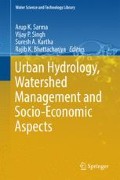Abstract
At the face of urbanization, the assessment of the behavior of precipitated water with terrain of varying slopes and varying soil types with or without vegetative cover has gained utmost importance. The fast growing cities and urban hubs clamor for a complete utilization of precipitation thus preventing the extreme situations of incessant floods or drought. This in turn creates an urge for making a study of the behavior of hydrological parameters such as infiltration and runoff with varying slopes and vegetation. These hydrological parameters may also be dependent upon the soil type. In this study, a series of experiments have been performed on an experimental setup known as Rainfall Apparatus and various hydrographs of infiltration flow-rate versus time and runoff flow-rate versus time are plotted from the obtained data thereby drawing certain specific and generalized conclusions. Regression equations with a coefficient of correlation of more than 97 % have been used to define the relationship between infiltration and other parameters.
Access this chapter
Tax calculation will be finalised at checkout
Purchases are for personal use only
References
Abrahams AD, Parsons AJ (1991) Relation between infiltration and stone cover on a semiarid hillslope, southern Arizona. J Hydrol 122:49–59
Balasubramanium K (1990) Engineering hydrology. Tata McGraw-Hill Publishing Company Limited
Basic Rainfall Apparatus Instruction Manual (2000) Norwood Instruments Limited, New Mill Road, Honley, Huddersfield, Great Britain
Calvo-Cases A, Boix-Fayos C, Arnau-Rosalén E (2005) Patterns and thresholds for runoff generation and sediment transport on some Mediterranean hillslopes. In: García C, Batalla R (eds) Catchment dynamics and river processes: Mediterranean and other climate regions. Elsevier, Amsterdam, pp 31–51
Cantón Y, Domingo F, Solé-Benet A, Puigdefábregas J (2002) Influence of soil surface types on the overall runoff of the Tabernas badlands (SE Spain). Field data and model approaches. Hydrol Process 16:2621–2643
Garg SK (1998) Soil mechanics and foundation engineering. Khanna Publishers
Li X, Contreras S, Solé-Benet A, Cantón Y, Domingo F, Lázaro R, Lin H, Wesemael BV, Puigdefábregas J (2011) Controls of infiltration–runoff processes in Mediterranean karst rangelands in SE Spain. Catena 86:98–109
Mayor AG, Bautista S, Bellot J (2009) Factors and interactions controlling infiltration, runoff, and soil loss at the microscale in a patchy Mediterranean semiarid landscape. Earth Surf Proc Land 34:1702–1711
Morbidelli R, Saltalippi C, Flammini A, Cifrodelli M, Corradini C, Govindaraju RS (2015) Infiltration on sloping surfaces: laboratory experimental evidence and implications for infiltration modeling. J Hydrol 523:79–85
Sarma AK, Giraud G, Baishya MD (2006) Rainwater harvesting for urban flood peak reduction, My Green Earth. J Soc Socio Econ Awareness Environ Prot SSEAEP 3(2):14–21
Seeger M (2007) Uncertainty of factors determining runoff and erosion processes as quantified by rainfall simulations. Catena 71:56–67
Sharma K, Singh H, Pareek O (1983) Rain water infiltration into a bar loamy sand. Hydrol Sci J 28:417–424
Solé-Benet A, Calvo A, Cerdà A, Lázaro R, Pini R, Barbero J (1997) Influences of micro-relief patterns and plant cover on runoff related processes in badlands from Tabernas (SE Spain). Catena 31:23–38
Yair A, Lavee H (1985) Runoff generation in arid and semi-arid zones. In: Anderson MG, Burt TP (eds) Hydrological forecasting. Wiley, New York, pp 183–220
Acknowledgements
The authors would like to acknowledge Civil Engineering Department of Indian Institute of Technology, Guwahati for all the support. The authors would also like to thank Dr. Diganta Goswami, Professor, Assam Engineering College, India, Mr. Anupam Das of Gammon India Limited and Mr. Navaratnam Leelaruban of North Dakota State University, USA for their invaluable suggestions and support.
Author information
Authors and Affiliations
Corresponding author
Editor information
Editors and Affiliations
Rights and permissions
Copyright information
© 2016 Springer International Publishing Switzerland
About this chapter
Cite this chapter
Sharma, A.S. et al. (2016). Impact of Slope and Vegetation on Hydrological Processes. In: Sarma, A., Singh, V., Kartha, S., Bhattacharjya, R. (eds) Urban Hydrology, Watershed Management and Socio-Economic Aspects. Water Science and Technology Library, vol 73. Springer, Cham. https://doi.org/10.1007/978-3-319-40195-9_1
Download citation
DOI: https://doi.org/10.1007/978-3-319-40195-9_1
Published:
Publisher Name: Springer, Cham
Print ISBN: 978-3-319-40194-2
Online ISBN: 978-3-319-40195-9
eBook Packages: Earth and Environmental ScienceEarth and Environmental Science (R0)

